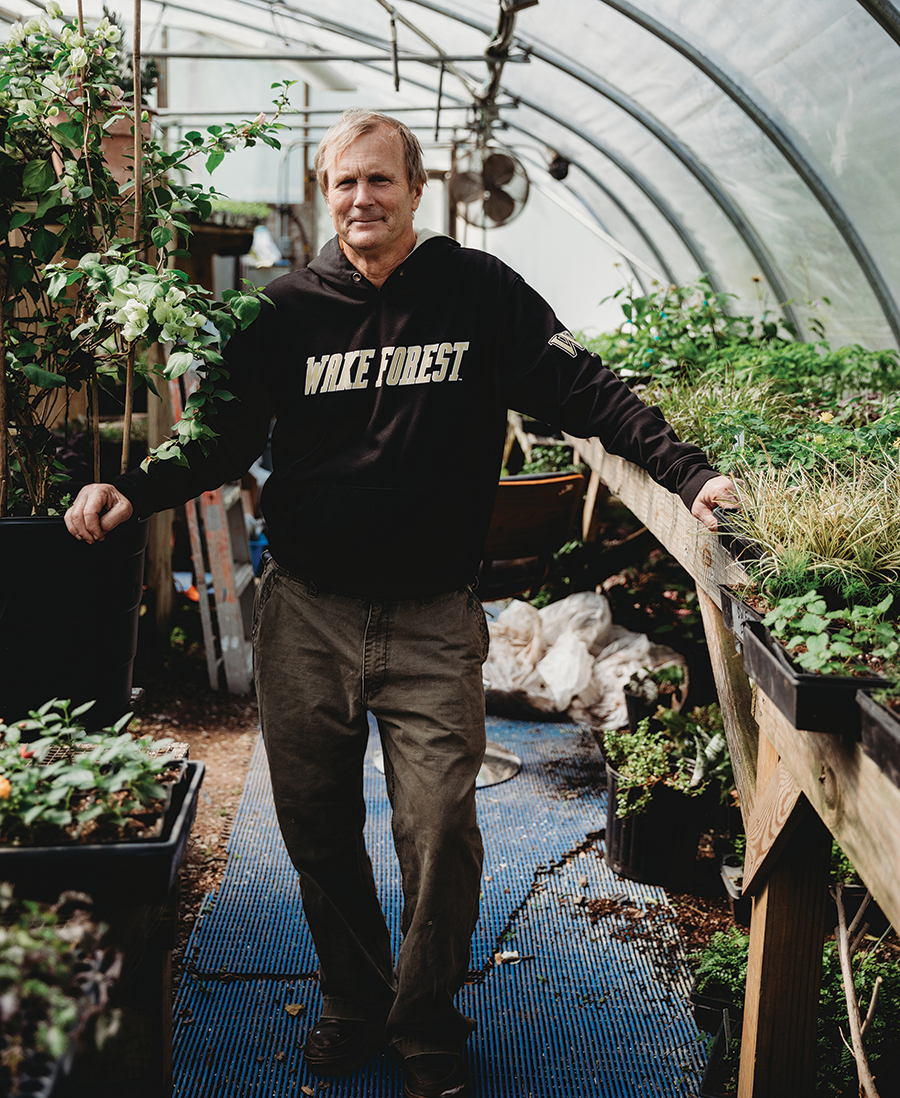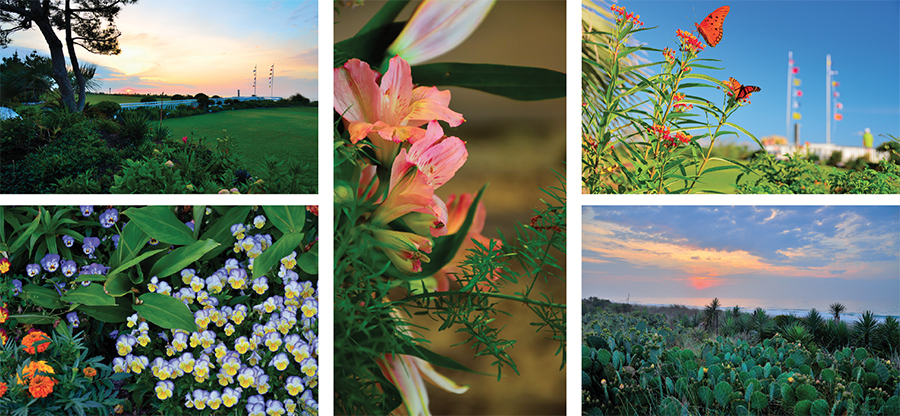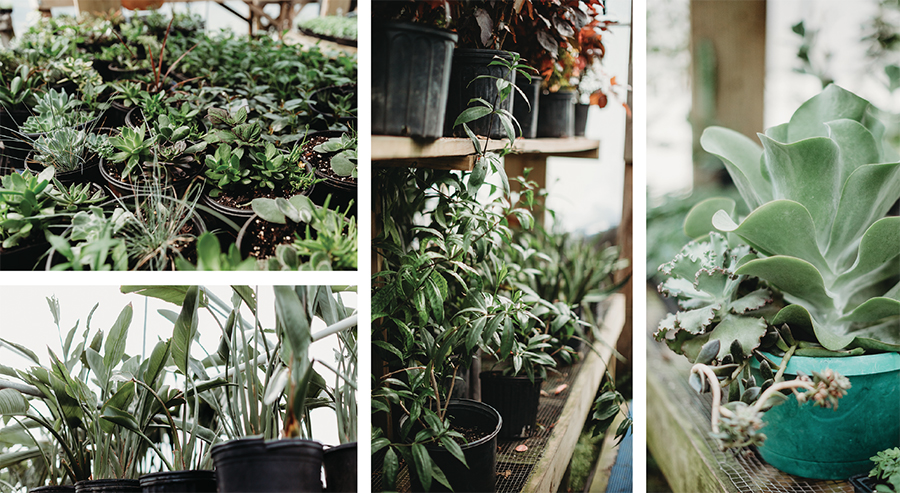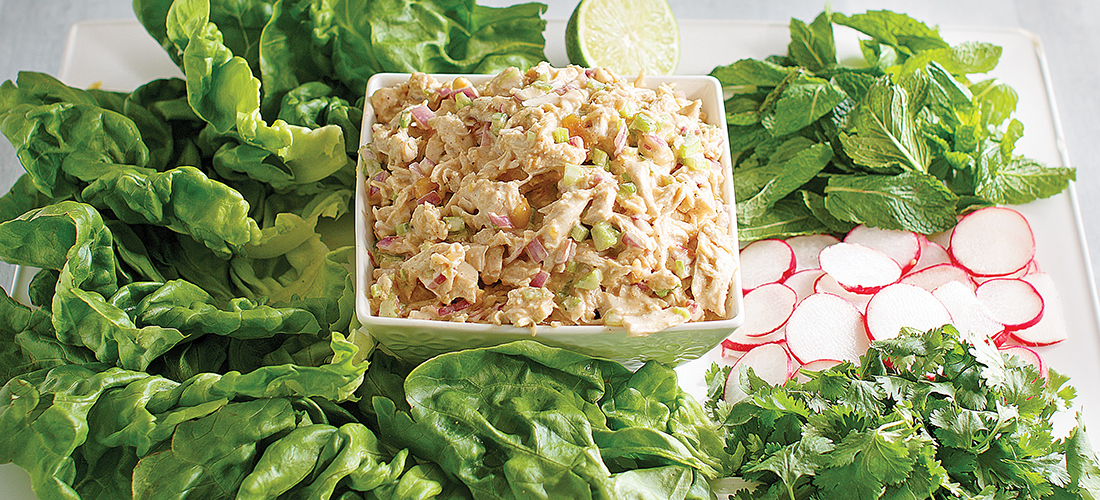It’s a tough business keeping a garden in bloom by the ocean’s edge, an endless battle against heat, salt and the occasional killer hurricane. But the Blockade Runner’s Aubrey Doggett does it beautifully, year after year
By Barbara J. Sullivan
He frets. He worries. He clucks over fallen pindo palms and rotten root balls. And it’s no wonder. Aubrey Doggett is a full-time gardener trying to sustain a richly planted landscape some 60 yards from the Atlantic Ocean’s high-tide mark. “You have to be crazy to do it at the beach,” he says. And yet he persists. He’s done so over a period of more than 30 years at the Blockade Runner, the much-beloved oceanfront hotel at Wrightsville Beach; and he’s done it well. In spite of constant salt spray, the occasional cruel winter freeze or soggy summer deluge and frequent heavy winds with their trifecta of sand-sear, desiccation and criminal battery, he’s determined to make it work. “Mother Nature’s fickle, and if you don’t have a sense of humor . . . well, you might take it personally.” Taking it personally would be a mistake. A garden at the beach is a set-up for disaster: rabbits, grubs, aphids, dollar weed, chickweed — to say nothing of heat, humidity and soil that runs through your fingers like — oh, wait — sand. And, of course, hurricanes.
In 1996, about 10 years after Doggett began tending to the gardens at the Blockade Runner, hurricanes Bertha and Fran leveled the dunes, destroyed the plantings and pumped water throughout the hotel’s first floor. With a bulldozer and 100 truckloads of masonry sand, he and his crew started the oceanfront gardens all over again. Since that time, five more hurricanes have hit or come near enough to cause concern. Most recently, in September 2018, with Hurricane Florence barreling down, the crew spent 15-hour days moving as many plants as they could to safety. What you hope for in a hurricane, Doggett says, is a lot of rain on the backside of the storm after the eyewall has passed. Otherwise, he says, “the salt will burn the heck out of the plants.”

Doggett has come by his gardening persistence through a lifetime of practice and curiosity. As a small boy growing up in the North Carolina Piedmont, he helped his father and grandfather with weekly chores of mowing, raking and weeding. One of his fondest memories is exploring the twists and turns of a boxwood maze in a neighbor’s garden. In Winston-Salem, his walk to school took him past the famed Reynolda Gardens, with its rich perennial borders and colorful annual displays. In Greensboro, he transformed his burgeoning knowledge of the plant world into a small business by freshening up neighbors’ yards each year in anticipation of the annual Wyndham PGA tournament. Over the years, he went on to cultivate golf course turf, manage his own landscaping business as well as cultivate plants for other landscapers and nurseries. When asked what kept drawing him to work in the dirt, he says, “I think it was just getting the immediate gratification from manipulating Mother Nature for another day.”
When he first got a part-time job bartending at the Blockade Runner’s Comedy Zone in the mid-1980s (back in the era when the not-quite-famous comedians Jerry Seinfeld and Jay Leno worked the crowd), Aubrey Doggett couldn’t possibly have imagined he would become the staff member in charge of developing and maintaining the gardens throughout the entire property. These include some 600 feet of street-front plantings, thickly planted beds rimming the front of the building and the parking lot, an acre-and-a-half of lawns and gardens facing onto the ocean and, as of 10 years ago, an ambitious landscaping project across the street on Banks Channel. Each spot has its own challenges and history.
At the very beginning, Doggett’s landscaping assignment was part-time and limited to keeping the lawns and beds on the ocean-side under control. From some deep-seated urge to propagate, however, he began expanding the lawn bit by bit, possibly under the general theory that no one would notice if it happened gradually enough. Each spring and fall, after he aerated the grass, he gathered up the leftover plugs and lined them up neatly where turf met sand dune. He then kept the new strips watered until they took root. He estimates that over the years he may have doubled the lawn area this way.

The broad stretches of manicured Tifway Bermuda grass are bordered by planting beds set off with granite boulders and Dixie pink gravel. The beds, richly populated with a variety of shapes, textures and colors, work as a framework for the various outdoor seating and pool areas. Doggett relies on plants that can take punishing heat, salt and wind. Among his favorites are the ornamental grasses like the majestic, deep burgundy/black fountain grass ‘First Knight’ or the towering yellow and green giant reed grass ‘Golden Chain.’ For architectural structure he’s chosen topiaried pines and dramatically bold pindo palms complemented by the abundant foliage of subtropical bananas, elephant ears and canna lilies, and a few true tropicals like bird-of-paradise and hibiscus. He’s learned to take advantage of plants that love nothing better than hot sun and perfect drainage. Among these are succulents such as ice plant, which grows willy-nilly in the crevices of the sago palm trunks, hens-and-chicks and the impressive century plant, with its 30-foot-tall bloom stalk. Grey-leaved plants are also notoriously tough customers; wormwood and dusty miller thrive in the ocean-side gardens.
The sound-side gardens include a long strip of land between the two hotel-owned piers. In the summer they’re lush with lawn grass neatly trimmed up to the edge of scalloped alcoves, each anchored with a stately palm and covered with a tapestry of brightly hued annuals and perennials. Doggett carved the alcoves both to create design interest and to provide shelter for more shade-loving plants. “I can do anything I want in there,” he says with a grin, “because there’s not the salt intrusion. Even though it faces west, it is pretty much protected.” The sound-side gardens are something of a surprise — more reminiscent of cool-weather gardens like those in New England in the summer, filled with dozens of varieties of plants. A small sampling might include sun-loving veronicas, lantanas and coneflowers and an assortment of shade-dwellers like ferns, caladiums and the striking neon-purple Persian shield. But there are so many more mixed in — the array is truly impressive.
Working as head groundskeeper at the Blockade Runner bears little resemblance to what the rest of us think of when we say we love to tinker in the garden. For a start, Doggett and his crew propagate plants by the thousands. “I got 10,000 cuttings two weeks ago,” he says by way of explaining why he’s been so busy lately. “I just finished those, and I have 20,000 coming in from Israel.” After the cuttings are unpacked, they’re placed in cell packs and rooted in a greenhouse for a number of weeks until they are sturdy enough to plant out in the gardens. These tend to be the seasonal fillers like pansies, snapdragons and kale in cool weather, and purslane and begonias in the hot months. Doggett intersperses these with perennials, palms, evergreens and grasses, which make up the backbone of the gardens. “The hurricanes really made me appreciate the natives,” he says, “and the stuff you see everywhere like the yaupons, the pittosporums, the podocarpus.”

After the planting there’s the watering. Although the grounds are watered by an irrigation system, it doesn’t reach all the plantings. Doggett estimates that on a given summer day in the midst of a lengthy drought, he can easily go through hundreds of gallons of water. “I have to be pretty stingy with the water because it’s so expensive. I don’t want to waste water. You want to have enough pressure to wet everything a little bit and rinse the salt off every day.”
And there are considerations home gardeners generally don’t have to worry about. For example, hotel guests will be looking down on the garden from their windows, which means plants can’t grow so tall that they block the view of the sailboat races or so subtle in color that they look washed-out from a distance. Bright reds, oranges, yellows and coral pinks seem to work the best. For the enjoyment of guests sitting out on the patio, Doggett has created raised berm plantings to block the glare of sun reflecting off of windshields in the parking lot. At one point, he added a touch of whimsy by having an artist friend carve tiki poles out of dead palm trees. And, in a commitment to climate-friendly alternatives, a portion of the gardens is now irrigated by recycled condensate from the A/C units, which is collected in a cistern and piped where it’s needed. Perforated underground tubing also helps filter run-off from the parking lot and the road.
As anyone who’s ever fiddled around in the dirt knows, a garden is never finished. The work continues year-round, year after year. It brings surprises and unexpected beauty. It brings sore disappointments from time to time. While other people may be sipping pina coladas on the patio, it’s a sure bet Aubrey Doggett will be tending to something — propagating begonias in the greenhouse, fertilizing the canna lilies in the flower beds, yanking the dollar weed out from among the horsetail reed, or rinsing the salt spray one more time off the leaves of every last living plant. “Here it’s such a quick turnaround,” he says philosophically. “You can feel so good about the day you had, and then you come back the next morning . . . you spend all day trying to get back to where you left it the day before . . . because of wind, because of the salt, because of the heat.” The fortunate hotel guests and the summer visitors who happen to catch a glimpse of these beach-garden wonders may be forgiven for thinking it all happened as if by magic. And for someone who has worked so hard at it over the years, that is probably the greatest compliment of all.
Barbara Sullivan is a regular Salt contributor and the author of Garden Perennials for the Coastal South.


